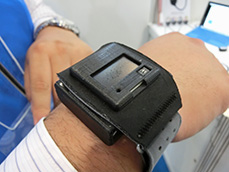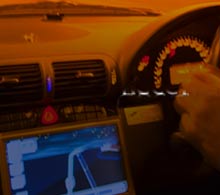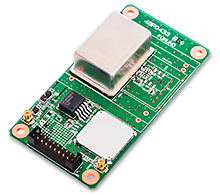Articles for ITS market “High precision 3D map” the key future of autonomous car and pedestrian dead reckoning
A new company for autonomous car is established by Japanese companies.
In Japan, there was a new topic regarding a map for the automotive industry.
On May 19th, 2016, the establishment of a company named “Dynamic Map Planning Co., Ltd” was announced. The company makes an original Japanese map for autonomous car.
In Japan, the development of an autonomous car named SIP (Strategic Innovation Promotion Program) is being led by the Cabinet Office, automotive manufacturers and universities. A high precision 3D map is being discussed a lot for the SIP. They are trying to make complex 3D maps, not based on 2D maps, but instead high precision 3D maps which are made by data gathered from LIDAR sensors and cameras.
Some map related companies are included in SIP. For example Mitsubishi Electric for measuring equipment, Pasco and Aisan Technology for software and Zenrin, Increment P and TOYOTA Mapmaster for map production. These six companies have been studying autonomous technologies and how to integrate dynamic maps.
The dynamic map has two kinds of fields. One is high precision 3D mapping field and another is a probe data field that contains a travel history and conditions provided by car. For an autonomous car the most important is understanding the car position and changes in the surrounding environment. Furthermore the updated information related to driving including traffic and weather and how they are used. They would like to make a “Live map” that shows the latest information by gathering and analyzing real-time data.
Dynamic Map Planning Co., Ltd is involved with the following nine automotive manufacturers, TOYOTA, NISSAN, HONDA, MAZDA, MITSUBISHI Motors, SUZUKI, FUJI Heavy Industries, ISUZU and HINO. They joined the company partnership to make a reference standard for the development of dynamic map data.
The Japanese government considers dynamic mapping a cooperative business in the automotive industry. Therefore the government does not want competition within the automotive manufacturers. The advantage of cooperating is development cost savings for the automotive manufacturers.
However in the autonomous car map business Here (company), TomTom and Google are trying to make their own map the de facto standard. Here (company) are from Germany, their background is that they were acquired by Daimler, BMW and Volkswagen in 2015. TomTom is from Netherlands and Apple is using their map in the iPhone. Google is part of Alphabet (parent company) and they are developing their own autonomous car technology.
What is PDR ?
Some people say “The importance of indoor tracking will become a larger factor in the discussion of autonomous car map business. This is because people think when the EV becomes very popular, people will drive indoors since there is no exhaust gas. In this case, Here or Dynamic map cannot be used once a car drives indoors and an indoor map will be needed. In a building the GPS or other satellites are not available so position needs to be measured by wifi or beacon systems. However these kinds of methods are only used in limited places like shopping malls or factories because of low popularity and utility.
In such a situation, PDR (Pedestrian Dead-Reckoning) is attractive as a technology for indoor position measurement. How can we measure a walker? It based on a ten-axis sensor composed of acceleration, angular velocity, magnetism, atmospheric pressure, walking motion measurement, velocity, posture direction and an estimate of the relative altitude variations. The benefits of PDR are the ability to track as lines, not points. The track is not like gathering many points but instead a continuous line including a form and curvatures.
In Japan there is a PDR Benchmark Standardization Committee and as of May 25, 2016, more than 30 companies and organizations are joining it. For example, Asahi Kasei, Asia Air Survey, KDDI R&D Laboratories, Kokusai Kogyo, Sharp, Hitachi, Ricoh etc.
MegaChips Corporation, a semiconductor manufacturer has already developed a dedicated semiconductor complete with a power saving motion sensor. Another product developed by NTT Docomo and ZENRIN-Datacom supplies an application named “Docomo map navigation” which can navigate underground or in subways.
Achieving an autonomous car that has no barriers, inside or outside
Currently a PDR that supports autonomous cars has not been developed but in the future there will be a Wi-Fi or beacon connected PDR that can achieve measurements for both indoor and outdoor positions using one device.
I think autonomous cars like sedans, minivans or other large vehicles like buses will be limited to driving indoors including indoor parking, etc. On the other hand, the autonomous vehicles like unmanned Segways and TOYOTA’s Winglet or ULV (Ultra Lightweight Vehicle) is planned for PDR standardization by the Japanese government and will have a larger indoor presence than the former.
I would like to see an advanced autonomous vehicle demonstration that has no barriers inside or outside in Tokyo Olympics, 2020.
Writer introduction

Mr. Kenji Momota Automotive journalist
His major is the world automotive industry and he is also familiar with the energy industry, IT and the aging society problem as the related fields. He acts around the world based in Japan and USA and writes for the general magazines, the technology journals and the automotive related media etc.
He is also commentator of motor race and world's motor show on TV program based on his career of the driver of Indy Racing League and NASCAR. In recent years, he has been covering about a paradigm shift from developed countries to developing countries, the motorized vehicle like EV and the telematics.
FURUNO ITS Journal
Click here for the latest articles after 2022 (in Japanese)2022
- The "realistic" self-driving roadmap shown by the Japanese government and a hands-on report on the latest Subaru EyeSight X
- Will FCVs (Fuel Cell Vehicles) Become Popular? ~New Movement in Toyota and Honda~
- The 'Complete' online sales of new cars start in Japan. Will this new way of buying cars take root?
- Many Firsts! On-Site Report from Tokyo Auto Salon 2022 - The author, who knows what goes on behind the scenes, looks back on 40 years of history. -
2021
- "Moving toward zero traffic fatalities for four-wheeled and two-wheeled vehicles globally in 2050" ~Experience on Honda's latest safety technologies~
- Tsuneishi Shipbuilding's building and DX, an exclusive visit to the main factory
- Japan's Smart City: New Moves toward Practical Use
- When will self-driving buses (service cars) be put to "full-scale" practical use?
- Utilization vehicle data during disasters
- Toyota-led Connected Technology to Transform Commercial Vehicle Business -From light trucks to large trucks and buses-
- Toyota enters the connected car "Personalization" business
- Japanese automakers' carbon-neutral strategies swept up in ESG investment
- Drive experience of the latest autonomous vehicle models and advanced driving support systems
- Will carbon neutrality accelerate the trend to strengthen LCA (Life Cycle Assessment)?
- Semiconductor shortage exposes realities of the automotive industry
- Online Autonomous Driving Contest Enhancing development of Human Resources
2020
- What happens to CASE when gas cars are banned in Japan?
- When will Flying Cars be launched?
- Expectation vs. reality:Autonomous Driving in Japan
- V2X, Becoming increasingly important in autonomous driving
- Technology of Subaru “EyeSight X”
- Lifestyle-oriented French cars gain popularity in Japan
- Human-oriented smart cities are wanted
- MaaS and CASE, how would automotive industry change after COVID-19?
- The beginning of virtualization era, triggered by COVID-19
- Trend of EV shift and consumer demands
- TOYOTA Press conference about ADAS - Releasing algorithm for "sudden acceleration suppression during attempted sudden acceleration" free of charge -
- The Japanese automotive industry in 2020 - 3 turning points -
- "Using a smartphone while driving" and "Level 3 automated driving"
2019
- Motor show business model is at a turning point - Tokyo Motor Show Report -
- Commercialization and monetization of MaaS - ITS World Congress Singapore Report -
- Android Automotive pays attention to V2X - Report from the Frankfurt Motor Show 2019 in Germany -
- Automobile Distribution Revolution and DCM (Data Communication Module)
- Connected business potential and newly proposed "eMaaS" by Honda
- 5G services for practical use are multiplying
- Connectivity technologies attracting attention due to frequent traffic accidents
- Shanghai Motor Show report -SUV, EV, Automated car & 5G-
- Drone Business roadmap and updates to Michibiki (Quasi-Zenith Satellite System)
- MaaS (Mobility as a Service) "town development." Full-scale promotion for a national project
- CES organizer states "Data Period in 2020s." Transformation of the Automotive Industry in CES, US "-CES2019 Report-"
- "Return to Origin" directed towards the age of change, automatic operation and connectivity
2018
- New proposal for Private Car Automated Driving Level and other Hot 5G Technology Topics
- Standardized EV charging infrastructure concerns in Europe, US, Japan and China - Kobe EVS 31 field report -
- Touring a pure car carrier and a test drive of the latest hybrid car
- Planning stage products are exhibited at the newly established visualized mobility service "TOYOTA MOBILITY SHOWROOM".
- Potential “Community Car-share” program promoted by local residents
- CES Asia Report 2108
- Companies attempt new Vehicle-to-Infrastructure communications, including traffic volume measurements and vehicle positioning. -ITS Asia Pacific Forum in Fukuoka-
- Geneva show in Switzerland. Flying cars and MaaS (Mobility as a Service) were hot topics.
- EV (Electric Vehicle) proposals by country
- MaaS competition through service mobilization, M & A and technical field collaboration is accelerating. - The CES 2018 Report -
2017
- Big data’s initiative and fight for the automotive industry. Cooperation among companies becomes increasingly important.
- Connected car and road-to-vehicle communication automatic operation
- ETC (Electronic Toll Collection) and ETC2.0. Current situation and projected future
- Rapid development of sharing economy
- Germany is first to recognize level 3 automated driving
- ITS EU 2017 Field Reports -Automatic Operation and the eCall-
- From Infotainment to ITS, the competitive area is spreading in the car big data industry.
- GTC (GPU Technology Conference) Report and the de facto standardization of AI (artificial intelligence)
- Renesas' new challenge! "e-AI Solution" and "Renesas Autonomy"
- The Automobile industry is shifting from a manufacturing industry to a service industry.
- The movement toward accident countermeasures for aging drivers in Japan
- Fusion of ride sharing and fully automated driving is advancing in the USA.
2016
- Overview of the Quasi-Zenith Satellite System (QZSS) and advancements toward full-scale practical use including the Tokyo Olympic Games - G-space EXPO 2016 report-
- Japan’s automated driving project "SIP-adus" will be a large demonstration experiment.
- The International Home Care & Rehabilitation Exhibition. There were many car manufactures with exhibits booths at this show.
- Japanese car manufacturers starting to concentrate on strengthening the ADAS system
- A new movement of legislation for autonomous cars
- Cyber Security and “AGL”, the new OS for automotive are hot topics in the connected car industry
- “High precision 3D map” the key future of autonomous car and pedestrian dead reckoning
- Chinese “BAT” is accelerating their business in the EV (Electric Vehicle) market
- Tesla's original connection to Taiwan and the new transportation system technologies.
- "The main topic" of the Geneva Motor Show was how to strengthen "pedestrian protection"
- The probe data business is getting more competitive
- Reporting directly from the 2016 CES show "Data services will soon become the main revenue source of automotive industry"
2015
- Do the automated driving systems need the GNSS (Global Navigation Satellite System) ?
- ETC Version 2.0 is coming soon. A new service was announced at the Tokyo Motor Show and the possibility that is could be used as a device for older drivers.
- "Connected Horizon" and "eHorizon". Germany's leading parts supplier accelerates strengthening of "Big Data" for business



 One IoT show held at Tokyo in June, 2016. There were many exhibitions of map information.
One IoT show held at Tokyo in June, 2016. There were many exhibitions of map information. The exhibition of Google’s Android Auto. It is a system that connects smartphone to display audio. The date of release in Japan is unknown but Google wants to increase their share in the automotive map market.
The exhibition of Google’s Android Auto. It is a system that connects smartphone to display audio. The date of release in Japan is unknown but Google wants to increase their share in the automotive map market. The HITACHI’s booth. There was an exhibition for the related partnership between HITACHI and Google. The company has couple of map products.
The HITACHI’s booth. There was an exhibition for the related partnership between HITACHI and Google. The company has couple of map products. Japanese AIST (The National Institute of Advanced Industrial Science and Technology) introduced their advanced technology and it also includes PDR (Pedestrian Dead-Reckoning).
Japanese AIST (The National Institute of Advanced Industrial Science and Technology) introduced their advanced technology and it also includes PDR (Pedestrian Dead-Reckoning). An example how to use ten-axis sensor on PDR (Pedestrian Dead-Reckoning).
An example how to use ten-axis sensor on PDR (Pedestrian Dead-Reckoning). The wrist watch type PDR made by Mega Chips Corporation
The wrist watch type PDR made by Mega Chips Corporation GPS/GNSS Receiver&Chips and Modules (positioning and timing)
GPS/GNSS Receiver&Chips and Modules (positioning and timing)